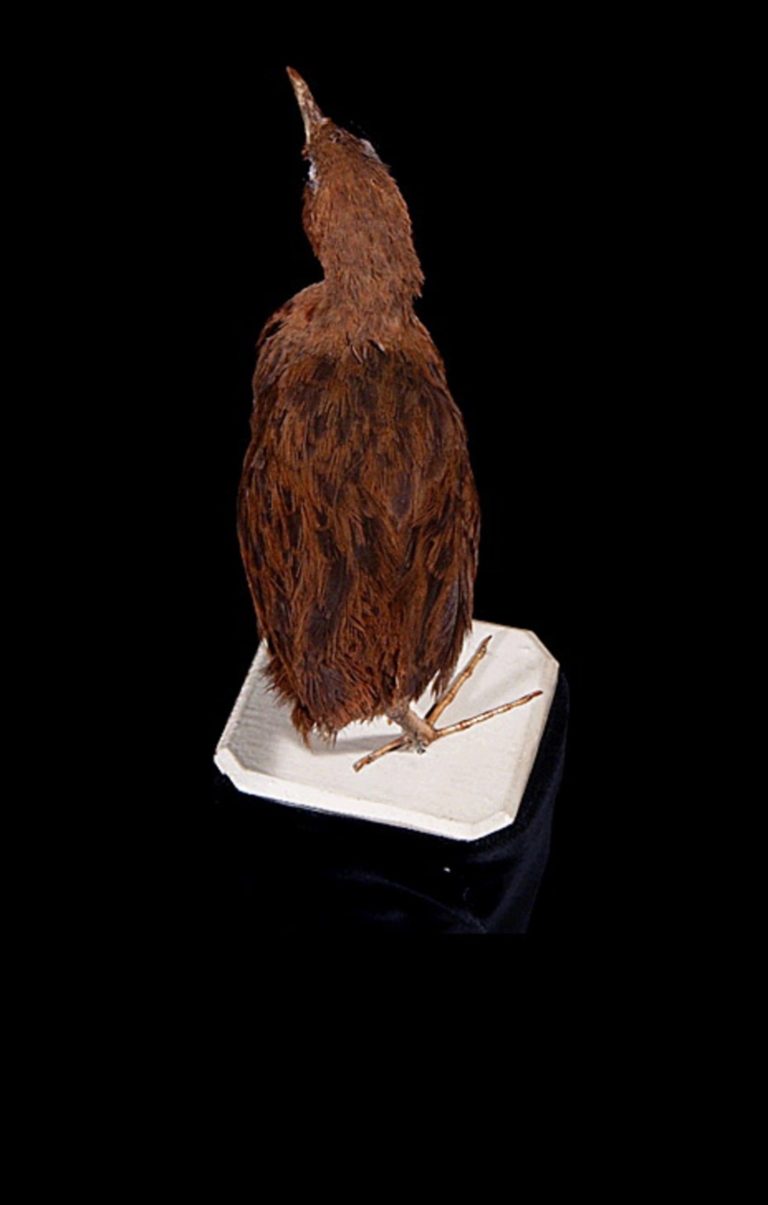Birdfinding.info ⇒ The Hawaiian Rail is known from seven specimens: two warm-toned, rusty individuals that Captain Cook purchased at Kealakekua, Kona, in January 1779, and five collected by a hired native bird-catcher, Hawelu, between 1859 and 1864 on the eastern side of the island along the road between Hilo and Kilauea. The last sighting that is considered reliable occurred in 1884 along the same road. (For a discussion of possible relationships between the Kona and Hilo birds see: Frontiers of Taxonomy: Did Two Flightless Rail Species Coexist on the Big Island?)
Hawaiian Rail †
Zapornia sandwichensis
Extinct. Formerly endemic to the Big Island of Hawaii.
Based on the specimens collected, it appears that different forms or species inhabited the dry and wet sides of the island: a rufescent form, the “Rusty Hawaiian Rail” (Z. s. sandwichensis), on the drier, western side and a dark-brown form, the “Dusky Hawaiian Rail” (Z. s. millsi), on the wetter, eastern side.
Identification
A small, flightless rail, thought to be related to Ruddy-breasted Crake, of eastern Asia. There are two known plumages, which may represent either two species, two subspecies, or two age-clasess, adult and immature.
“Rusty Hawaiian Rail” (Z. s. sandwichensis), regarded by many as the immature plumage of Hawaiian Rail, was bright rufous throughout, with darker streaks on the upperparts. Its legs were yellowish and its bill was pale-brown.
“Dusky Hawaiian Rail” (Z. s. millsi) was mostly uniform dark-brown with grayish tones on the belly and upperparts. Its legs were orange-yellow and its bill was mostly dark.

Hawaiian Rail, Z. s. sandwichensis and millsi. John Gerrard Keulemans, 1900

“Dusky Hawaiian Rail,” Z. s. millsi. (Cat. BM 1939.12.9.553, Natural History Museum at Tring, U.K.) © Andrew Esposito

“Rusty Hawaiian Rail,” Z. s. sandwichensis, ventral view. (Specimen ID: RMNH.AVES.87450; Big Island, Hawaii.) © Naturalis Biodiversity Center

“Rusty Hawaiian Rail,” Z. s. sandwichensis, side view. (Specimen ID: RMNH.AVES.87450; Big Island, Hawaii.) © Naturalis Biodiversity Center

“Rusty Hawaiian Rail,” Z. s. sandwichensis, dorsal view. (Specimen ID: RMNH.AVES.87450; Big Island, Hawaii.) © Naturalis Biodiversity Center
Notes
Polytypic species consisting of two recognized subspecies: a paler one from the drier, western side of the Big Island (sandwichensis, known from two specimens), and a darker one from the wetter, eastern side (millsi, known from five specimens). There has been some dispute as to whether these represent separate species, distinct subspecies, or merely different plumages (adult and immature) of a single subspecies (see Frontiers of Taxonomy: Did Two Flightless Rail Species Coexist on the Big Island?).
IUCN Red List Status: Extinct.
References
BirdLife International. 2016. Zapornia sandwichensis. The IUCN Red List of Threatened Species 2016: e.T22692693A93364994. https://dx.doi.org/10.2305/IUCN.UK.2016-3.RLTS.T22692693A93364994.en. (Accessed June 5, 2020.)
Hume, J.P. 2017. Extinct Birds (Second Edition). Bloomsbury Publishing PLC, London.
Pyle, R.L., and P. Pyle. 2017. The Birds of the Hawaiian Islands: Occurrence, History, Distribution, and Status. Version 2 (January 1, 2017). http://hbs.bishopmuseum.org/birds/rlp-monograph/. B.P. Bishop Museum, Honolulu, Hawaii.
Ripley, S.D. 1977. Rails of the World: A Monograph of the Family Rallidae. David R. Godine, Publisher, Boston.
Taylor, B., and B. van Perlo. 1998. Rails: A Guide to the Rails, Crakes, Gallinules, and Coots of the World. Yale University Press.
